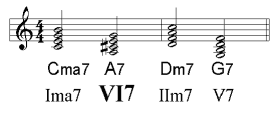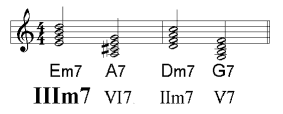Basic Chords
Before we look at more complex jazz chords and progressions, we should have a look at on of the most basic chord types, which is a triad, so-called as it has only 3 notes: the root, 3rd and 5th notes of the scale.

Important: for the purposes of counting the number of different notes in a chord, we do not count notes duplicated in different octaves.
This example shows the chord three ways
- In its most basic form, three notes stacked up from the root: C, E & G
- As an inversion, ie in a different order. In this case it is a first inversion: E, G & C
- With an extra note at the top, however this is still a triad because the extra note at the top is the same note (C) repeated up an octave: C, E, G & C
Beyond Triads: Adding a Fourth Note
Triads are very common in many forms of classical music, folk, rock and pop but in jazz they are not often used, instead at least one other note is added, usually the 7th note of the scale (but sometimes the 6th), see below in example 1b. We often have notes beyond the 7th (called upper extensions) but for now let’s look at our basic set of four note chords.

Why 6ths?
A 6th is an alternative to the major 7th on chords I and IV. This usually occurs when either:
- The 6th is the melody note. In this case there obviously must be a 6th in the chord.
- The root is the melody note
If the melody note is the root of the chord, it causually doesn’t sound great to have the major 7 just below it dues to the semitone interval .
Note: this semitone interval is fine when it is between inside parts of an inversion of a chord, however when it is a semitone away from the melody it usually sounds bad as it becomes confused with the melody note.
Different chord types
We have four different types of four-note chords in a major key:
| Chord | Symbol | Defining Intervals |
| I and IV | major 7 | contains major 3rd and major 7th |
| V | (dominant) 7 | contains major 3rd and minor 7th |
| II, III and VI | minor 7 | contains minor 3rd and minor 7th |
| VII | half diminished (minor 7 b5) | contains minor 3rd, a diminished flattened) 5th and minor 7th |
We call these diatonic, which means that there are no chords with notes not in the key signature.
It’s a good idea to use the roman numeral system when learning this as it helps you know what the chords are in any key; e.g. you will learn that chords II, III and VI in any major key are always minor 7 chords.
Recap on Roman Numeral (RN) analysis:
This is a great way to analyze a tune.’s harmony so instead of using the actual chord symbols (Gm7 – C7 -F67), we use the roman numerals (IIm7 – V7 – Imaj7). Some people use lower to mean minor (e.g. ii7 – V7 – I) but this can be misleading.

Different types of chords based on one root
Now that we know the basic different types of chords in any given key, let’s just take a step back so we can view and compare the chords types built on the same root:
| Chord type | Possible functions in different keys |
| Major 7 | I of C, IV of G |
| Dominant 7 | V of F |
| Minor 7 | II of Bb, III of Ab, VI of Eb |
| Half diminished (minor 7 flat 5) | VII of Db |
Diminished and Augmented chord types
There are two further basic chord types that are not diatonic in a major key but are also very important:

The diminished 7 chord. We don’t always write the “7” in the chord symbol as it is safe to assume with jazz that it’s nearly always a four note chord
The augmented chord. . In jazz this is nearly always a dominant 7 chord with an augmented 5th so it is best to refer to it as a 7 augmented (As in C7 augmented).

Note that “7” on its own always means a dominant 7 type chord, a major 7 is always denoted”major” or one of its abbreviations.
The table below shows some alternative “spellings” for common four note chord symbols. There is a more comprehensive table on the jazz chord symbol chart
Alternative “spelling” of chord symbols
| C major 7 | Cmaj7 | Cma7 | C Δ | CM7 |
| C7 | C7 | |||
| C minor 7 | Cm7 | Cmin7 | C-7 | C- |
| C half diminished (minor 7 b5) | Cø7 | Cm7 b5 | Cmin7 b5 | C-7 b5 |
| C diminished 7 | Co (7) | C dim (7) | ||
| C7 augmented | C7+ | C7aug | C7+5 | C+7 |
Correct enharmonic spelling always a good idea to help understand how chords are built and how they function, e.g. the 7th degree of a B major scale is A# not Bb, the 3rd of Eb minor is Gb not F#. One exception is when you use diminished scales and arpeggios, tritone substitutes or if using the correct enharmony would make a part very difficult for a musician to sight-read.
Chord progressions
Once we know some chords, we can start putting them together in a sequence or progression.
One of the most basic chord progressions is I-VI-II-V:

As with classical harmony there are 3 main areas of harmony: tonic, subdominant and dominant. This is very important to understand as it can help you to “tell a story” and give your music some form in regard to building up tension and releasing it so it can be a good idea to think of tonic as “home”, subdominant as “away from home” and dominant as “returning home”.
1) Tonic or Home
This obviously includes chord I, but can also includes chord III and sometimes chord VI. The chords are similar because their roots are a diatonic third away from chord I (three out of the four notes of these chords are the same as those in chord I). Chord III is often used as a substitute for chord I.
2) Subdominant area
Traditionally this is chord IV but also includes chord II and sometimes chord VI. Chord VI is a diatonic 3rd away from chord I and chord IV hence it can be seen either as tonic or subdominant, depending on context. In jazz the II chord is more common than the IV chord as a subdominant, but it also functions very commonly as a “lead in” to the dominant V chord. IV is very common as a subdominant in blues.
3) Dominant area

Chord V and chord VII. The dominant quality of a chord is usually defined by the tritone (flattened 5th) interval which creates what is traditionally thought of as a dissonance or a need to resolve to a chord that sounds more at rest. In this example the tritone resolves by the B rising to C and the F descend to E.
The VII is rarely used as a dominant.
Secondary Dominants
Conventionally a secondary dominant is a V7 of V7 chord: in the key of C, instead of preceding G7 by Dm7, the G7 is preceded by D7 – the dominant chord in the key of G. An actual modulation does not occur because the G is not a tonic, it is a G7 and therefore functioning in the key of C (ex 2c). In this case it is created by chromatically altering the 3rd of the Dm7 chord from minor to major.

ex 2c: Secondary dominant: chord II7 (V7 of V)
In practice any chord that is not a tonic chord can be preceded by a secondary dominant.
When analysing this progression we call it II7-V7-I. From this it is obvious that the II chord is a dominant 7th rather than a minor 7th, which would have been called “IIm7”.
If we look again at a I-VI-II-V sequence we could instead create a secondary dominant of the IIm7 by chromatically altering the VIm7 to VI7. It is extremely common to alter the VI chord in this way: one advantage of changing m7 chords to secondary dominants is that there are more interesting sounding extensions and alterations available on dominant 7th chords.

ex 2d: Secondary dominant of II
It is also very common in jazz to use chord III as a substitute for chord I (see Tonic Area)

ex 2e: Substitution of chord III for chord I
Although they never actually resolve, the Em7 and A7 could be also viewed as IIm7 V7 in the key of D. In this case the 3rd scale degree of the tonic is not present in either chord so the key center could actually be either D major or D minor. For now we shall consider this alternative key centre to be D major.
Looking at it like this, there are two ways to describe the progression in ex 2e using RN analysis:
(a) C: IIIm7-VI7-IIm7-V7-Ima7 etc.
(b) D: IIm7-V7 C: IIm7-V7-Ima7 etc.
Method (a) defines all the chords in their relationship to the key of the tune.
Method (b) defines the chords in their relationship to the key centres (D and C) for each of the II-V progressions.
Although theoretically method (a) is the correct analysis – A7 is a secondary dominant: it precedes Dm7 which is functioning in the key of C so the progression does not actually modulate – in practice method (b) can often be more useful to the improviser (See Modes)
A secondary dominant can have its own secondary dominant. We could take a diatonic IIIm7-VI7-IIm7-V7 sequence and make all the minor 7 chords secondary dominants.

ex 2f: (1) Diatonic III-VI-II-V sequence
(2) Minor 7 chords replaced by secondary dominants*
N.B. These chords are voiced to allow the top and inside parts to move smoothly. (Compare the root position voicing in ex. 2c, d and e). This type of voicing is typical of horn parts or right hand piano voicing. A bass part or left hand would normally supply the roots.
If you have any questions on chord progressions please feel free to ask on Cafesaxophone


